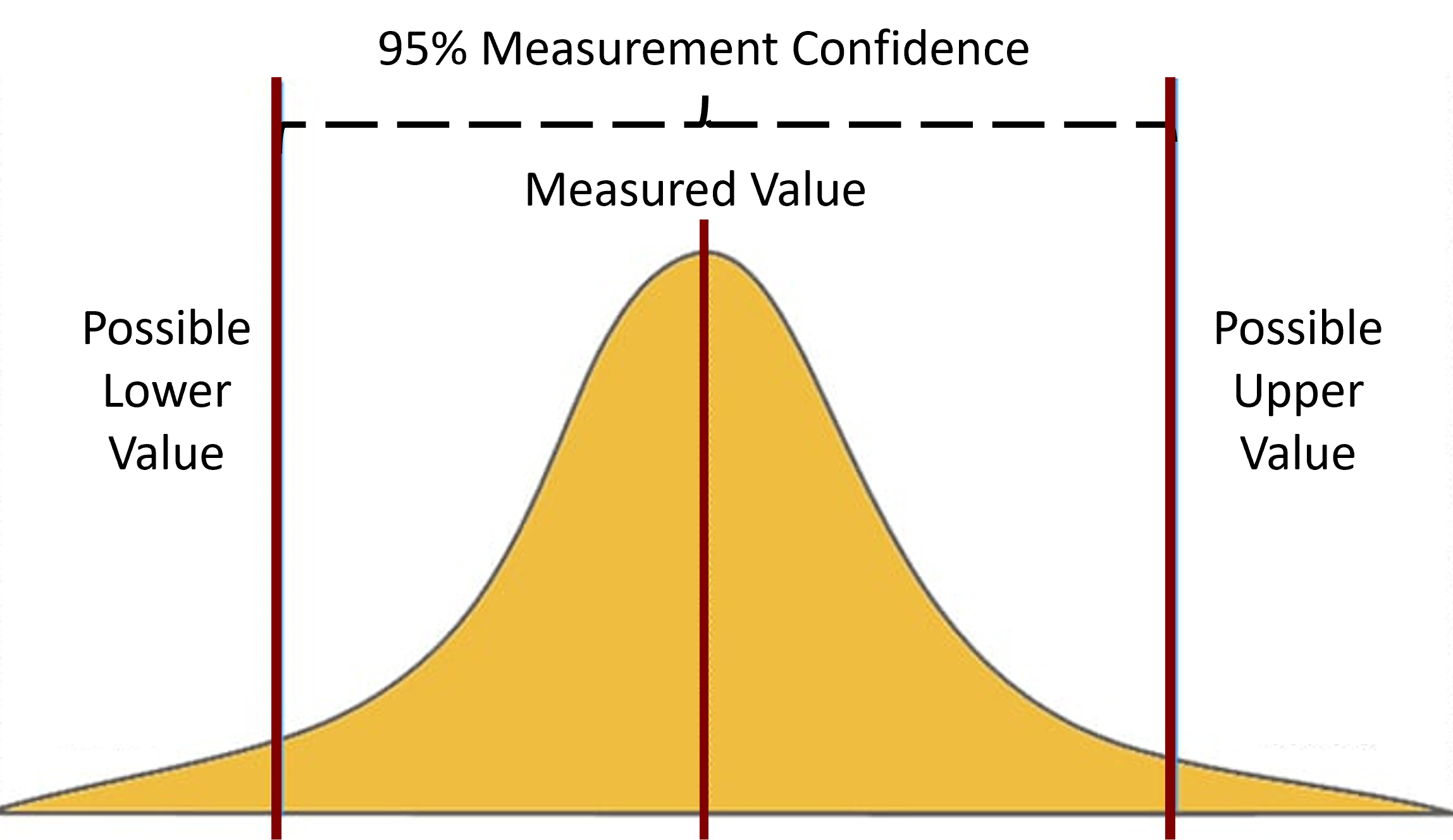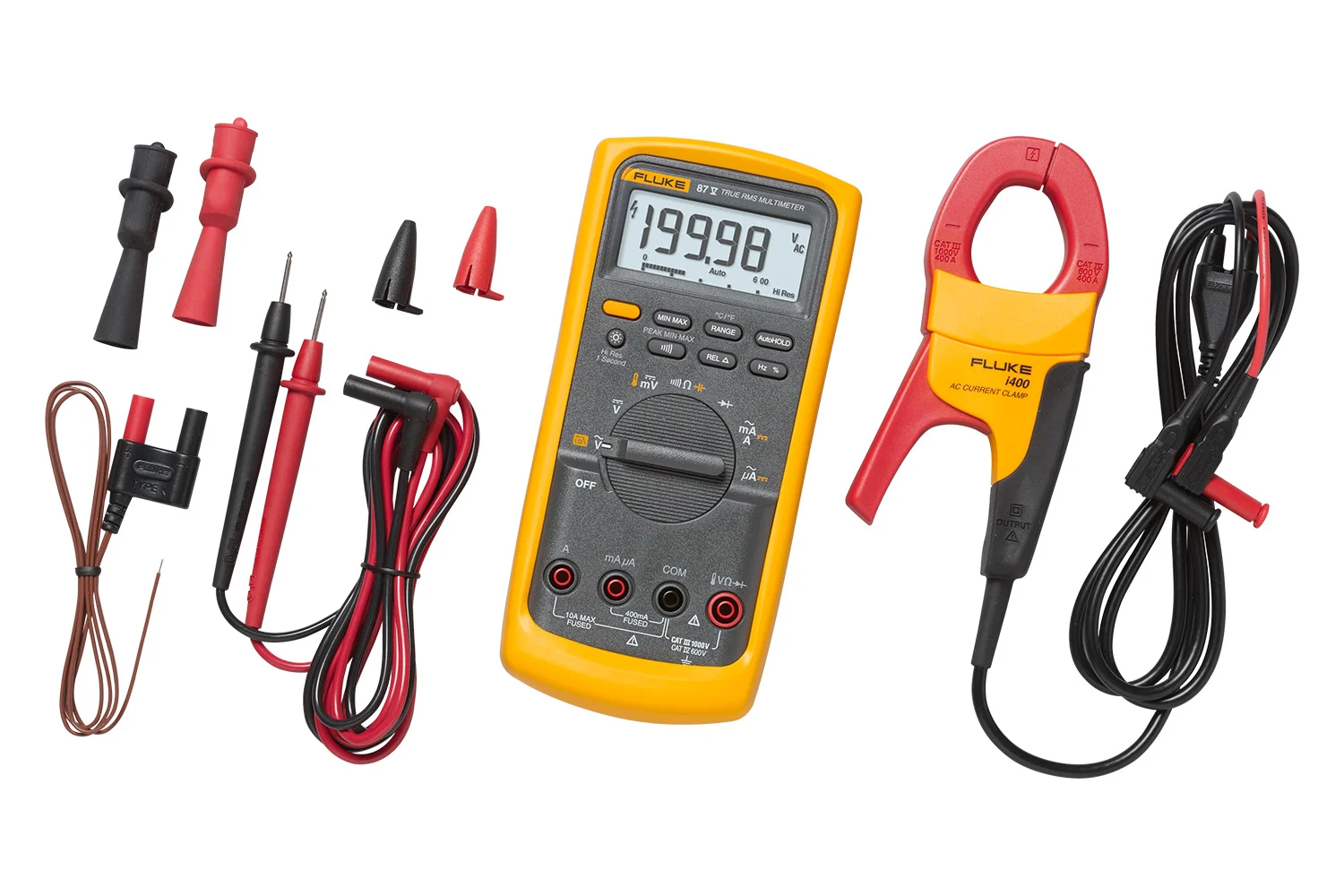Multimeter Accuracy
The Definitive Guide To Using Multimeters
Multimeter Accuracy
The most common portable digital multimeters have an accuracy of ±0.5% for DC voltages. Benchtop multimeters are commonly specified with an accuracy of ±0.01%, or even better.
The accuracy of a multimeter is about how close the measured values are to the true values of the electrical parameters. It's crucial for any measuring tool because it tells us how reliable and trustworthy the measurements are.
It is easiest to think of this as a target. The "true value" of the target is the center bullseye. The "measured values" would be like graphing where all your arrows hit around that bullseye. The accuracy of your shot is how far those arrows are hitting from the bullseye.

Multimeter Accuracy
Multimeters typically come with a specified accuracy percentage or tolerance indicated by the manufacturer. This accuracy value indicates the maximum permissible deviation between the displayed reading on the multimeter and the actual or true value of the measured parameter. For example, a multimeter with a ±1% accuracy means that the displayed value can deviate by a maximum of 1% from the true value.
the Definitive Guide to Using Multimeters
This is the 10th article in our series, The Definitive Guide to Using Multimeters.
This article delves into the common types of multimeter leads and the most frequent data output options available.
In This Article
- Multimeter Accuracy
- Why Is Knowing the Accuracy Of A Multimeter Important?
- Selecting a Multimeter With The Correct Accuracy
- Multimeter Accuracy vs. Multimeter Resolution
- Multimeter Accuracy Factors
- Multimeter Accuracies
- Multimeter Counts vs. Digits
- Sample Multimeter Accuracy - Fluke 87 V Specifications
If you missed the start of the series: What Is a Multimeter: The Definitive Guide to Multimeters, check it out now! You will be able to work your way back to this article quite quickly.
The Definitive Guide to Multimeters
- What is a Multimeter?
- Why Are Multimeters Important?
- What Do Multimeters Measure?
- What is the History of the Multimeter?
- What are the Common Types of Multimeters?
- What are Common Multimeter Options?
- What are Some Multimeter Specifications?
- What are Common Uses of Multimeters?
- How Do I Choose the Best Multimeter For The Job?
- How Do I Use a Multimeter?
- How Do I Properly Maintain a Multimeter?
- How Do I Calibrate a Multimeter?
- What is the Future of Multimeters?
- Multimeter FAQs
Why Is Knowing the Accuracy Of A Multimeter Important?
Knowing the accuracy of your multimeter is vital to gaining accurate readings. Simply put, due to a number of factors, a multimeter will always have a certain level of uncertainty in the measurement it provides.
The uncertainty of a measurement is the probability that the reading of the measurement you are taking is true. Because of this, having a higher ratio between your multimeter's accuracy compared the fluctuation of the source will give you a higher likelihood that the measurement you just took is true.
Nearly all circuits will be defined with an acceptable variation of the measurement you are taking. This is known as the tolerance. For example, fluctuations of around ±5% or greater are common in AC power line voltages. This means your standard 120 V AC receptacle could very well be supplying anywhere from 114 to 126 volts of electricity. As a result, the tolerance of this measurement is ±5% (or ±6 volts).
When selecting a multimeter for the measurement, the standard rule-of-thumb is a multimeter should be 4 times more accurate than the tolerance of the measurement you are performing, while 10 times more accurate is preferred. This is known as the Test Uncertainty Ratio (TUR). If the 4x rule is used, you can trust (within a 95% confidence level) that the measured value will be precise enough to confirm that the measurement you are taking is in tolerance.
Multimeter Accuracy - Measurement Uncertainty

The chart below shows what this looks like when comparing the measurement tolerance to the uncertainty ratios, when the measurement is theoretically at the nominal (e.g. 120 volts).
Multimeter Accuracy - Test Uncertainty Ratio

The second bar of the above chart represents a multimeter that has a 4:1 uncertainty ratio, while the third bar represents a multimeter that has a 10:1 uncertainty ratio. The height of the two bars represents the possible values the measurement you just performed could actually be.
Let's say your measurement was X. When you bring the accuracy of the multimeter into consideration, what you are really saying is, "The measurement was X ±Y" - where Y is the uncertainty of the measurement. As you can see, the multimeter with a 10:1 uncertainty ratio gives is far more accurate and gives you much more confidence in the measurement you have just taken.
Most commonly though, the measurement that you take does not come in exactly at the nominal of what you are measuring. Let's pretend the measurement you take comes about halfway between the nominal value and its acceptable upper limit. The chart then would look something like this.
Multimeter Accuracy - Passing Measurement

In this case, the measured value is far enough away from its upper limit that both of the multimeters will give you a passing measurement. You can be confident that the measured value is truly well within its acceptable tolerance. However, if the measured value is far closer to its upper limit, we start to run into issues. This is shown in the chart below.
Multimeter Accuracy - Within Uncertainty

In the case of the 10:1 uncertainty ratio multimeter, you can see that even though we are approaching the upper limit of the tolerance of the measurement you are taking, we are still within tolerance. However, when looking at the 4:1 uncertainty ratio multimeter, the confidence band of the measurement has gone above the upper limit. This, unfortunately, means that you could wind up failing a perfectly fine circuit - causing higher costs to redo the work. On the flip side of this, you could accidentally pass a circuit that is actually above its tolerance limit - causing potential safety issues.
Selecting a Multimeter With The Correct Accuracy
Admittedly, the above information is a bit "in the weeds". To bring it back to the real world, let's consider an outlet in your house. As we stated above, the tolerance of AC line voltage to your house is ±5% (or ±6 volts). If the sole purpose of using the multimeter is to measure the voltage of an outlet, you would use the Test Uncertainty Ratio (TUR) to decide which multimeter could do the job. If a 4:1 ratio is good enough for you, then a model with a measurement accuracy of ±1.25% is just fine. Anything with an accuracy ratio lower than that
However, other industries require a much more precise measurement. If you are manufacturing, say, a pacemaker the tolerances given will be much tighter. An incorrectly manufactured unit could have dire consequences for the user. Because of this, the specifications of the pacemaker may only allow a variance of ±1% of the specified voltage. As a result, you will need to be far more accurate in your testing. In this case, you will need a far more accurate multimeter to perform the measurement - in the area of ±0.1%.
Multimeter Accuracy vs. Multimeter Resolution
One common thing that often gets confused, is that multimeter accuracy and resolution are not interchangeable terms.
As we already discussed, accuracy focuses on the error between the measured and true values.
Resolution, however, refers to the smallest increment or step size that the device can display. It determines the level of detail or granularity in the measurements it provides. Resolution is typically specified in terms of the number of digits or counts that the multimeter can show.
To understand this more, let's revisit the target example from earlier.
Multimeter Resolution

The image on the left represents a multimeter with "full" resolution, while the one on the right has half the resolution of the other. If you look at each circle as a "bucket", the measurements have twice as many buckets to fall into on the image with a higher resolution.
To understand resolution a bit better, lets consider two separate bathroom scales. Assuming these imaginative scales are analog scales, there will be markings along the scale readout. One scale may have a dash for each pound, while some scales may have half-pound increments. Both scales could be equally as accurate. However, the scale with the finer, half-pound resolution, will allow you to get a more dialed in reading. An example of this is below.
Scale Resolution Example

As you can see, the scale that has half the resolution, you will have to take a decent guess. You can tell its over halfway between the marks, but you don't really know exactly how much. You will be far more accurate with your estimation of the measured weight with the scale that has twice the resolution.
So accuracy and resolution are interrelated in the sense that higher resolution can enhance the ability to discern smaller changes and make more precise measurements, capitalizing on the accuracy of the unit. Nevertheless, even with high resolution, accuracy is crucial for ensuring the reliability of the measured values. In other words, a multimeter that has the highest resolution on the market, does not mean much if its inherent accuracy does line up.
Multimeter Accuracy Factors
The accuracy of a multimeter can be influenced by various factors, including:
- The display type of the multimeter (analog vs. digital)
- The construction type of the multimeter (portable vs. benchtop)
- The resolution of the display
- The quality of its internal components
- How well/recently it has been calibrated
- Current environmental factors
Each type of multimeter tends to have its own average accuracy, due to the specific type of construction each multimeter has. The most notable difference is between analog and digital multimeters.
As mentioned earlier, analog multimeters are generally less accurate than their digital counterparts. Due to the analog display, rather than a digital readout, the accuracy of an analog multimeter is hindered due two factors not present in a digital multimeter:
- The user's experience reading analog measurements and likelihood of misinterpretation of the scale
- The consistency of the user’s viewing angle of the display
However, analog multimeters can still provide reliable enough measurements in many scenarios. On average, analog multimeters have an accuracy of around ±3% to ±5% of the full-scale reading.
The accuracy of digital multimeters (DMMs) varies depeding on the quality and specifications of the device, but is most impacted by the construction of the multimeter.
High-quality handheld digital multimeters typically offer accuracies ranging from ±0.1% to ±0.5% of the full-scale reading.
Benchtop multimeters are designed to provide precise measurements and are typically calibrated more frequently to maintain their accuracy. The average accuracy of benchtop multimeters can range from ±0.01% to ±0.05% of the full-scale reading.
Of course the quality of a multimeter's components is also going to have a very large impact on the overall accuracy of it. As the old saying goes, "You can polish a turd, but its still a turd."
We will be discussing the importance of multimeter calibration in great detail later on in this series, but the most important thing to know is that a recently and properly calibrated multimeter will be the most accurate multimeter.
Multimeter Accuracies
Until this point, we have discussed measurement accuracy for the voltage component of multimeters. However, as you recall, there are many types of measurements a multimeter can perform.
The type of measurement a multimeter performs will have its own accuracy considerations.
Multimeter Voltage Accuracy
Voltage accuracy is typically expressed as a percentage of the reading plus a fixed number of digits (or counts). Common voltage accuracies include ±0.5%, ±0.1%, or even better, depending on the multimeter's quality and intended application. Higher-end multimeters may offer higher voltage accuracies for more precise measurements.
Multimeter Current Accuracy
Current accuracy is also usually expressed as a percentage of the reading plus a fixed number of digits (or counts). Common current accuracies range from ±0.5% to ±1%. Higher accuracy is often required for low-current measurements compared to higher current ranges.
Multimeter Resistance Accuracy
Resistance accuracy is typically expressed as a percentage of the reading plus a fixed number of digits (or counts). Common resistance accuracies range from ±0.5% to ±1%.
Multimeter Capacitance Accuracy
Capacitance accuracy is often expressed as a percentage of the reading plus a fixed number of digits (or counts). Common capacitance accuracies range from ±1% to ±5%.
Multimeter Frequency Accuracy
Frequency accuracy is usually specified as a percentage of the reading plus a fixed number of digits (or counts). Common frequency accuracies range from ±0.1% to ±1%.
Multimeter Temperature Accuracy
Temperature accuracy is typically expressed as a fixed number of degrees Celsius (°C) or Fahrenheit (°F) that the measurement may deviate from the true value. Common temperature accuracies range from ±1°C to ±5°C.
|
Measurement |
Analog Multimeter Accuracy |
Digital Multimeter Accuracy |
Benchtop Multimeter Accuracy |
|
Voltage |
±3% to ±5% |
±0.1% to ±0.5% |
±0.01% to ±0.05% |
|
Current |
±3% to ±5% |
±0.5% to ±1% |
±0.05% to 0.5% |
|
Resistance |
±3% to ±5% |
±0.5% to ±1% |
±0.1 to 0.5% |
|
Capacitance |
N/A |
±1% to ±5% |
N/A |
|
Frequency |
N/A |
±0.1% to ±1% |
±0.05% to 0.1% |
|
Temperature |
N/A |
±1°C to ±5°C |
N/A |
It is also important to note that accuracy for each measurement type is usually specified under certain conditions, such as within a specific temperature range. It is essential to refer to the manufacturer's specifications to understand the accuracy limitations and any additional considerations.
Multimeter Counts vs. Digits
Most accuracy statements for measuring devices allow for a set adjustment, in addition the plus or minus accuracy statement.
In the context of multimeter accuracies, the terms "counts" and "digits" refer to different ways of expressing the resolution of the measurements a multimeter can make. Understanding these terms is crucial for evaluating the accuracy of a multimeter.
Multimeter Counts
"Counts" represent the maximum number of distinct numeric values a multimeter can display on its screen. For instance, a 3½ digit multimeter can display numbers up to 1999 (9999 for a 4½ digit multimeter). The term "counts" indicates the total number of individual values that can be shown.
Multimeter Digits
"Digits" refer to the number of digits in the measurement display. For instance, a 3½ digit multimeter will display values as ###.#, where '#' represents a digit. Similarly, a 4½ digit multimeter will display values as ####.#. The term "digits" indicates the number of digits that are shown in the measurement readout.
When discussing the accuracy of a multimeter, these terms play a role in understanding how precise the instrument is in terms of the values it can measure and display. Let's break down the relationship between counts and digits:
-
A 3½ digit multimeter can display values ranging from -1999 to 1999.
-
A 4½ digit multimeter can display values ranging from -1999.9 to 1999.9.
In terms of accuracy, the "counts" or "digits" specification helps you understand the range and resolution of measurements the multimeter can provide. Higher counts or digits generally indicate a more precise and accurate multimeter, capable of showing smaller changes in the measured values.
For example, with a 3½ digit multimeter, each count represents a change of 1 in the last digit of the display. In a 4½ digit multimeter, each count represents a change of 0.1 in the last digit. This finer resolution allows for more accurate readings, especially when dealing with smaller changes in measurements.

Multimeter Counts vs. Digits
Sample Multimeter Accuracy - Fluke 87 V Specifications
To tie this all together and get a good idea of how the accuracy of a multimeter is typically defined, let's take a look at the specifications of the Fluke 87V Handheld Multimeter. This is likely the most common multimeter in use today, and will give a great representation of multimeter accuracies.

Fluke 87V Handheld Multimeter & Accessories (Image Source: Fluke Corporation)
The specifications below were taken from Fluke's product literature of this multimeter.
|
Voltage DC |
Maximum voltage |
1000 V |
|
Accuracy |
±(0.05% + 1) |
|
|
Maximum resolution |
10 µV |
|
|
Voltage AC |
Maximum voltage |
1000 V |
|
Accuracy |
±(0.7% + 2) True RMS |
|
|
AC bandwidth |
20 kHz with low pass filter; 3 dB @ 1 kHz |
|
|
Maximum resolution |
0.1 mV |
|
|
Current DC |
Maximum amps |
10 A (20 A for 30 seconds maximum) |
|
Amps accuracy |
±(0.2% + 2) |
|
|
Maximum resolution |
0.01 µA |
|
|
Current AC |
Maximum amps |
10 A (20 A for 30 seconds maximum) |
|
Amps accuracy |
±(1.0% + 2) True RMS |
|
|
Maximum resolution |
0.1 µA |
|
|
Resistance |
Maximum resistance |
50 MΩ |
|
Accuracy |
±(0.2% + 1) |
|
|
Maximum resolution |
0.1 Ω |
|
|
Capacitance |
Maximum capacitance |
9,999 µF |
|
accuracy |
±(1% + 2) |
|
|
Maximum resolution |
0.01 nF |
|
|
Frequency |
Maximum frequency |
200 kHz |
|
Accuracy |
±(0.005% + 1) |
|
|
Maximum resolution |
0.01 Hz |
|
|
Duty cycle |
Maximum duty cycle |
99.9% |
|
Accuracy |
±(0.2% per kHz + 0.1%) |
|
|
Maximum resolution |
0.1% |
|
|
Temperature measurement |
–200.0 °C – 1090 °C |
|
The first thing to note is that nearly all accuracies are defined as ±X% + Y. The "Y" is the additional allowance of a number of "counts", as described above.
Additionally, you will see the maximum resolution is also called out separately for nearly all the measurement types also.
What's Next: The Definitive Guide to Multimeters
By now, we have gone further into the weeds on multimeter accuracy than you may have ever even known was possible.
In the next section, we will explore another common multimeter specification, its range. Lets get started and head to Section 11: Multimeter Ranges.
ISO/IEC 17025 Accredited Multimeter Calibration
Fox Valley Metrology proudly offers accredited precision measuring instrument calibration services of Multimeters. We calibrate all types of Multimeters at our offices throughout the country, meaning we are sure to have local Multimeter calibration services near you.
- ✓ ISO 17025 accredited calibration vendor
- ✓ Broadest calibration scope in the industry
- ✓ 3-5 day turnaround time for laboratory calibrations
- ✓ Pickup and delivery service options available
- ✓ Onsite calibrating service options